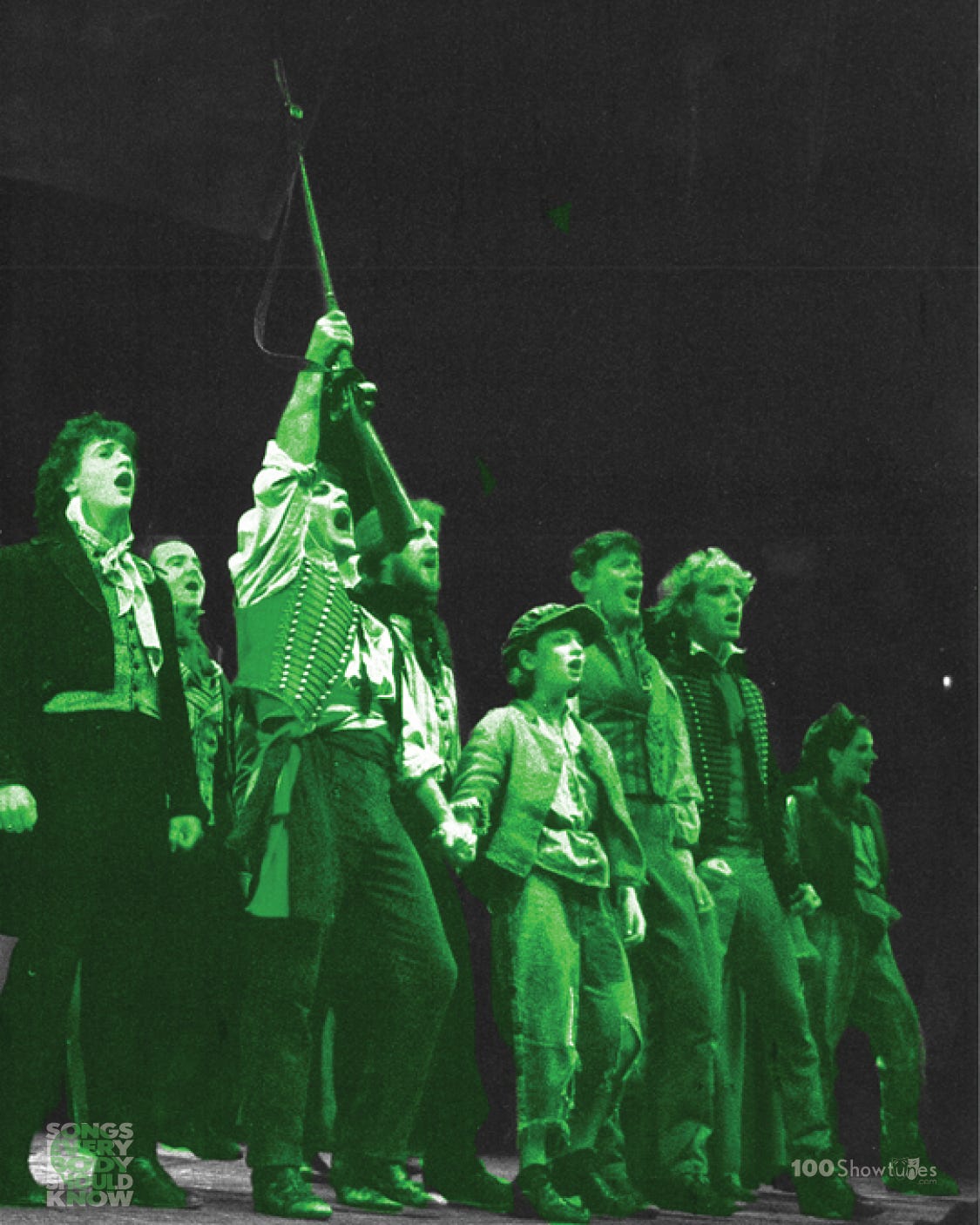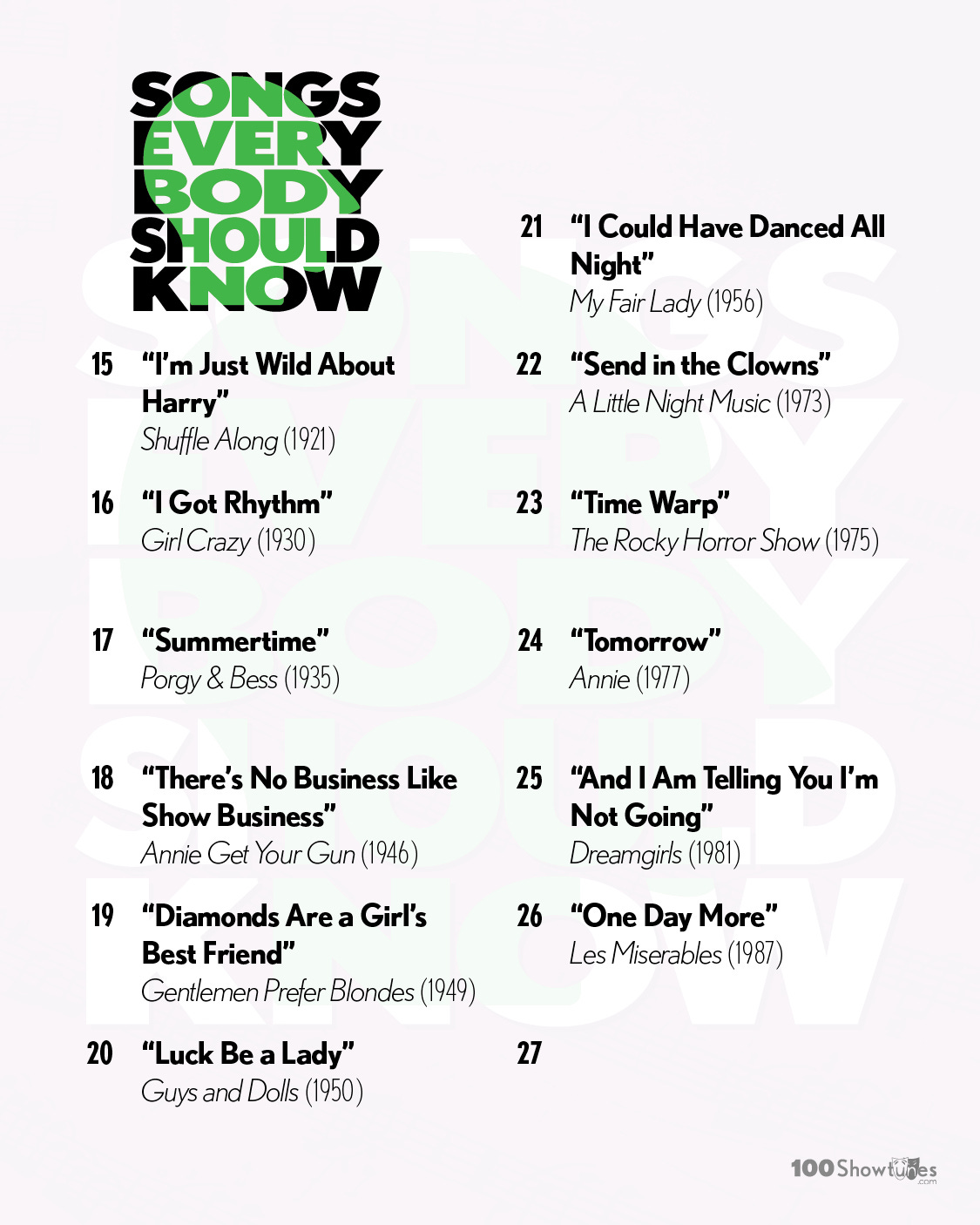No. 26. “One Day More”
LES MISERABLES (1987). By Claude-Michel Schönberg (music, book), Alain Boublil (book, original French lyrics), Herbert Kretzmer (English lyrics). Based on the novel by Victor Hugo.
Spring 1987. You’re at Les Miserables (known colloquially as Les Miz unless you want to show off your 3 years of High School French). It’s the latest British Mega-Musical from producer Cameron Mackintosh. Instead of a falling chandelier or a tire that rises to kitty cat heaven, the spectacle is in the sheer scope of story telling, putting Victor Hugo’s doorstop of a novel onstage with a brilliant staging by Trevor Nunn and John Caird that uses a turntable, a versatile cast, and a lot of costume changes to cover twenty years, and nearly as many locations. It opens at a prison where one man (Jean Valjean) is held for stealing a loaf of bread to feed his starving family. He escapes, and the prison guard (Javert) makes it his mission in life to find Valjean. Talking about living rent free in someone’s mind! A decade later, Valjean is a wealthy business man and mayor. He befriends a factory worker (Fantine), a single mother who is working to support her daughter (Cosette) who is living in the care of an inkeeper and his wife (the Thernardiers). Fantine sells her hair, becomes a prostitute, and dies, with Valjean vowing to take care of the child. He rescues Cosette from the Thernardiers, who have been abusing Cosette while spoiling their own daughter, Eponine. Another decade later, Valjean and Cosette, now a young woman, live a priviledged life marred by a lot of moving around and secrecy to stay ahead of the ever persistent Javert. Cosette falls in love with a young man named Marious, who Eponine (now decidedly not living in luxury) also loves. Marious hangs out with some revolutionaries led by the idealistic Enjorlas. On the evening before an attack planned by the revolutionaries, the key players sing about what’s going on with them at that moment in “One Day More.”
I don’t think anyone expected a Royal Shakespeare Company adaptation of a little known French concept album based on a 1,300+ page novel written in 1862 to become the world’s most popular musical. Although the concept wasn’t as out-there in the mid 80’s as it might seem today. First, the RSC had a major international hit a few years prior with an epic 8-hour (non-musical) adaptation of Charles Dickens’ Nicholas Nickleby, directed by Trevor Nunn and John Caird. Second, the Brits were usually down for a prog-rock concept album. So I can see how someone thought to pair those two ideas. But it’s rather miraculous that Nunn, Caird, and French songwriters Claude-Michel Schönberg and Alain Boubil managed to pull it off. They focused the sprawling narrative on the major themes of justice, devotion, and honor—which aren’t common subjects for a musical—and then through in some unrequited love and signing urchins. The sung-through score makes even long stretches of recitative catchy and fun, with recurring musical motifs that tie the evening together1. Epic act 1 finale “One Day More” might be the ultimate showtune. It’s like the “Tonight (Quintet)” on steroids. If you start playing the opening vamp of “One Day More,” you WILL end up with a room of people singing along—it’s the song they play at Marie’s Crisis when it’s too crowded, and no one is listening or paying attention, and they just need everyone to shut up and sing. It’s heroic, romantic, and comedic. And which character you sing along with is a more accurate personality test than the INFJ. (Unless you’re Jinx Monsoon and just do all the parts.)
Recommended Recording: ”One Day More,” Les Misérables: The Dream Cast in Concert (1995)
Cameron Macintosh celebrated the 10th Anniversary of Les Miserables’s London premier with an epic concert featuring a “Dream Cast” of notable performers from productions worldwide. While this has since become a fairly common practice (particularly for Macintosh productions), it was really a novel concept at the time. More unusual was the fact that the concert was filmed, aired on PBS in America, and given a home video release, even as the original London and Broadway productions were still running. It proved a point that producers today are still hesitant to learn: Making a show more accessible for at-home consumption is just as, if not more, likely to generate interest in the production than deter people from buying tickets to live performances. This telecast was the first Les Mis for millions of people. And none of them would accuse Macintosh of hyperbole for calling this a “dream cast.” It’s largely a mash-up of the original London and Broadway casts, along with Philip Quast from the original Australian production, and Lea Salonga, who was a replacement Eponine on Broadway, but most associated with Boubil and Shönberg’s follow-up musical, Miss Saigon. (She would play Fantine in the first Broadway revival.) Everyone is definitive and supported by a large orchestra and chorus.
Alternate Performances
Les Miz has received ~46 cast recordings, the most recent being a new 2024 Paris cast. Other international recordings include Belgian, Czech, Danish, Dutch, Flemish, Hungarian, Israeli, Japanese, Korean, Manchester, Madrid, Polish, Prague, Rotterdam, Swedish, Vienna, and Québec casts. It’s been spoofed by Saturday Night Live, South Park: Bigger, Longer, Uncut, and late night talk shows.
The “Original” Casts - Les Miz has three “original” cast recordings. First, there’s the recording that started it all—the 1980 French Concept Cast.It’s really fascinating to hear this early version, knowing what the show would become. Also, it’s fun to hear the characters actually sing in French. The 1985 Original London Castis the 14th best-selling cast recording of all time, achieving Platinum certification in 1998. You may also know it as “the one with Patti LuPone,” who originated the role of Fantine. 1987 Broadway Cast is the 2nd best-selling cast recording of all time, and 4x platinum certified. Colm Wilkinson and Frances Ruffelle reprise their London roles as Valjean and Eponine, but the rest of the cast was new for Broadway.
1988 Complete Symphonic Recording - The first complete recording of the full score. It features many members of the original Australian cast (which did not otherwise get a recording), along with actors from other international productions, including Kaho Hamada from the Tokyo production. The complete recoding is the 29th best-selling cast recording of all time. In an odd twist, a one-disk “highlights” edition (which is the very opposite of “Complete”) sold even better and is the 26th all time best-selling cast recording
2012 Film - Tom Hooper directed the film adaptation of Les Mis, making the controversial decision to record all of the vocals live while filming, rather than having the cast act along to pre-recorded vocals. I personally get very annoyed when the signing is so clearly in a different universe than what I see on screen, so I loved this choice and wish other directors followed suit. The counter argument (which is valid and probably the majority opinion) is that some of the cast would have been bettered served by studio recordings that could be enhanced (or even replaced outright with stronger singers). Hugh Jackman stars as Valjean, and your perception of the movie’s length is inversely proportionate to how much you enjoy Jackman’s voice on all these sustained high notes. Anne Hathaway filmed “I Dreamed a Dream” as one take and won an Oscar. The theatrical performers (like Aaron Tveit and Samantha Banks as Enjorlas and Eponine) fared better than some of the more “Hollywood” stars (like the much maligned Russel Crowe). The movie was successful enough to give Hooper the green light for Cats.
Is it Covered by The Rat Pack, Audra McDonald, or Glee?
Audra McDonald sings “One Day More” as the finale to the Carpool Karaoke segment she appears in. James Corden says “I really feel like we can’t have this many Broadway legends in a car and not do one song. Are you going to come with me on this? It’s just one song more.” Lin Manuel Miranda starts off as Valjean, then Jesse Tyler Ferguson as Marius, Audra as Cosette, Jane Krakowski as Eponine, and James Corden as Enjorlas. Audra also has fun with the Javert and Thernadier bits and ends it with a crazy operatic high note, because she can.
Glee does not feature “One Day More.” However, it features another Les Miz song, “On my Own,” in the pilot as Rachel Berry’s audition song (the first and last time a character on Glee does exactly what a regular human person living in central Ohio would do). “I Dreamed a Dream” appears in “Dream On” (season 1 episode 19) as a dream sequence in which Rachel hears the voice of her biological mother (literally Idina Menzel) for the first time. That same episode features Will Shuster (and Neil Patrick Harris) auditioning for a community theater production of Les Mis, though they don’t sing anything from the musical. In Season 4, episode 19 (“Diva”), Kurt challenges Rachel to sing “Bring Him Home” in a “Diva-Off.”
In the Wings
We only have 1 SESK left, and that will drop next week. Until then, no discussion about Les Miz is complete without mentioning Forbidden Broadway’s hilarious parodies (whose lyrics I know better than the real ones). They have the classic “More Miserable” sequence from Forbidden Broadway Vol. 2 and “Ten Years More” from Forbidden Broadway Cleans Up Its Act.
I also have an update to last week’s post—it came to my attention that Sammy Davis Jr. performed “And I Am Telling You…” in the 1980s, including on a Jerry Lewis MDA Telethon. I have updated the post online, but it won’t change what already appeared in your inbox.
When I was 8 I saw a tour of Les Miz with my mom, and I was asking all sorts of precocious questions throughout. When the women came out in act 2 (after the failed revolution) and sang “Turning, Turning,” I said “this is the same melody as a street walkers from act 1–is there supposed to be a connection?,” which caused the woman in front of us to turn around and gawk. But 30+ years later I STILL HAVE THE SAME QUESTION.




